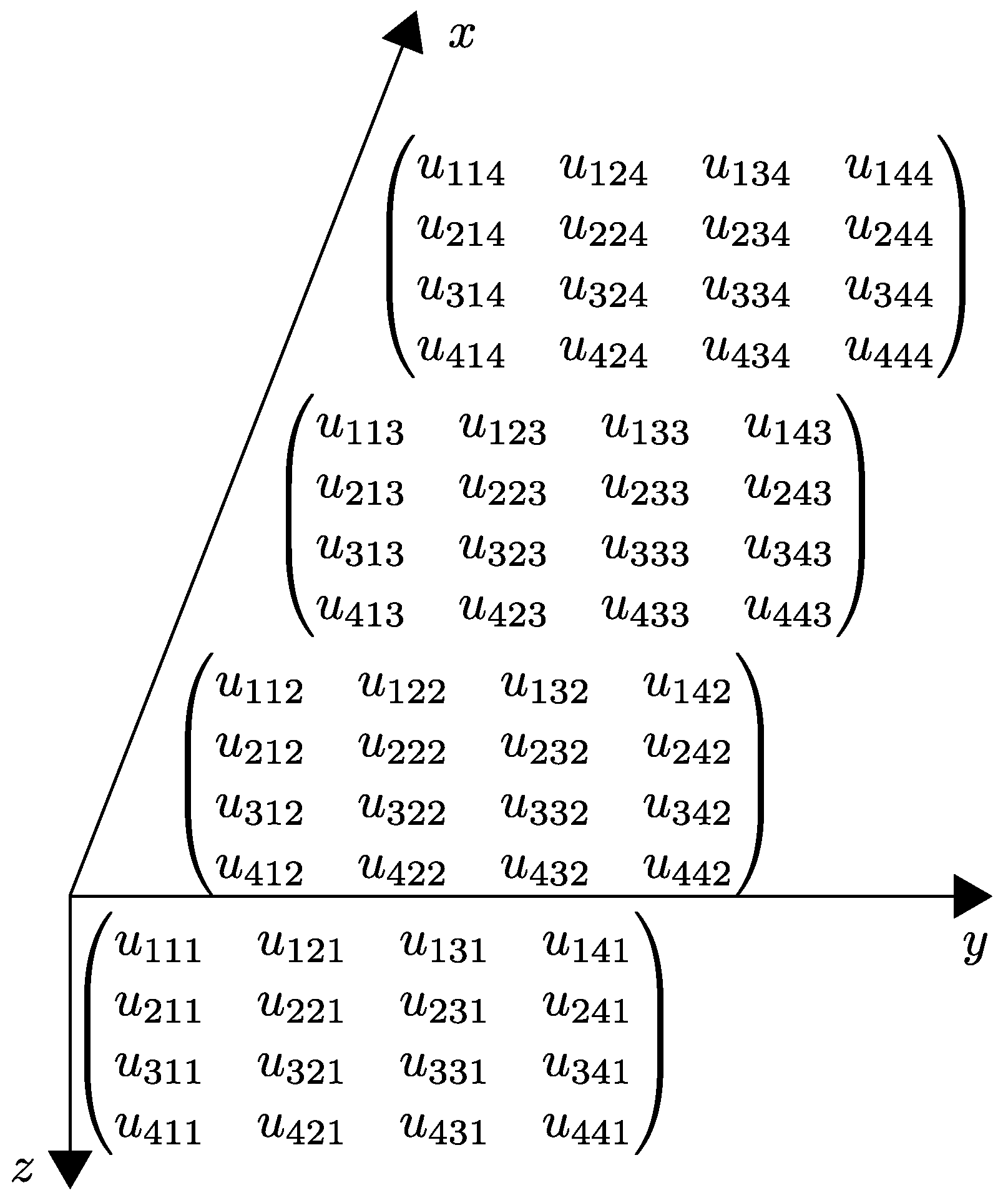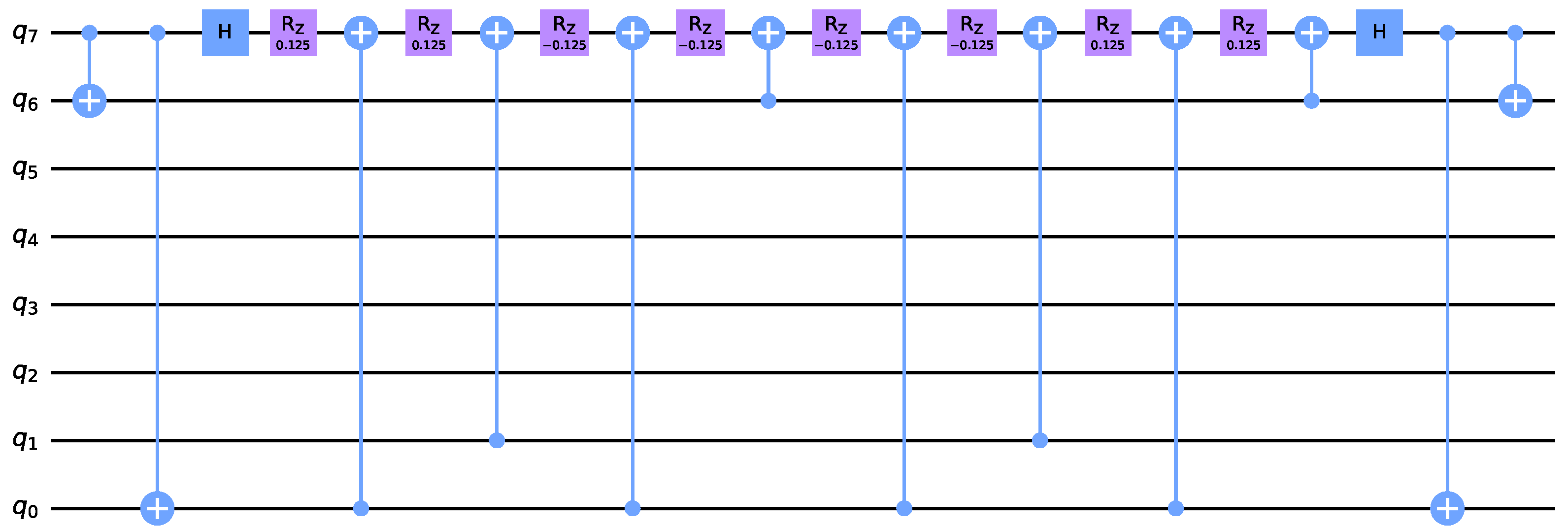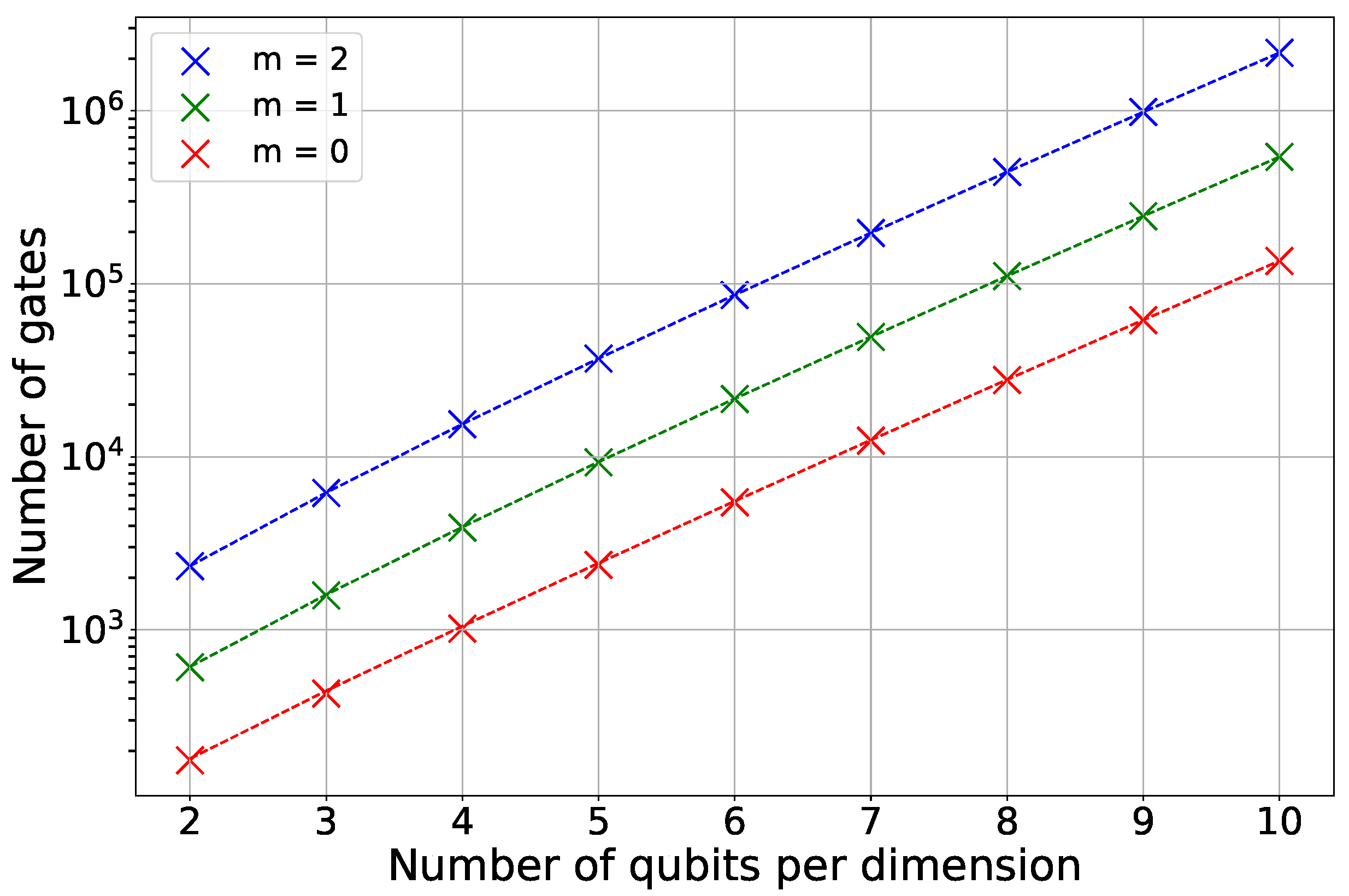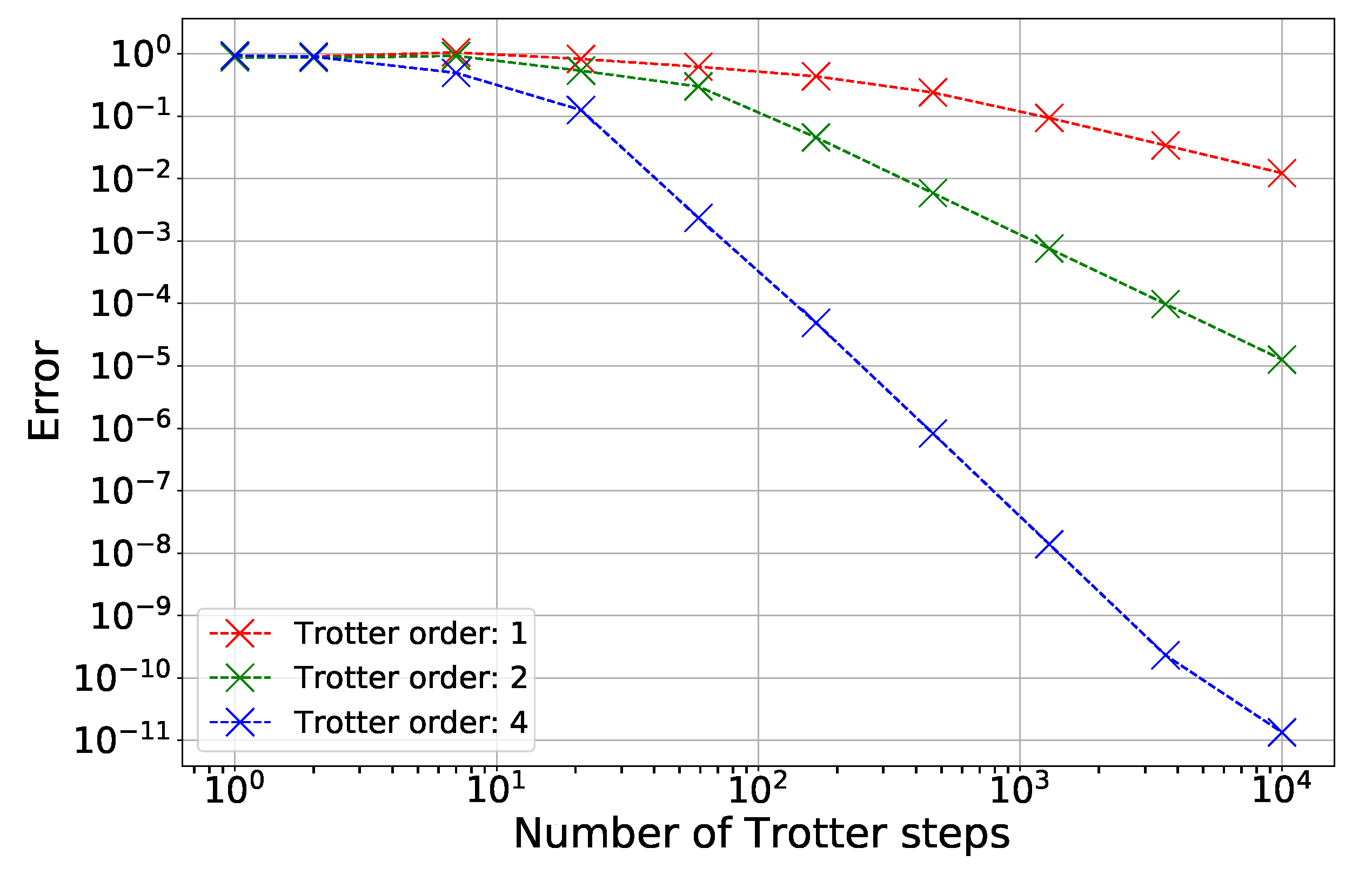This section outlines our findings in the form of propositions and corollaries. We express the propagator for the multidimensional wave equation using single and two qubit operations as follows:
3.1. Pauli String Decomposition
We extend the results presented in Proposition 1 from [
16], particularly focusing on the case of a block Hamiltonian
H with dimensions
.
Proposition 1 (Decomposition of a block Hamiltonian)
. The only Pauli strings that can have non-zero coefficients in the decomposition of matrixwhere , , are d-diagonal matrices with , described by , where andwhere , , , , . Moreover, the main diagonals of are represented by , with where .Here, function returns the number of bits necessary to represent D in binary form. Meanwhile, provides the binary form of b with a specified length a, padding with leading zeros if necessary. The symbol ∗ denotes the concatenation of binary strings.
It is noteworthy that if is not a power of 2, this proposition can still be utilized by appending matrices for , where is defined as . The d-diagonal matrices referenced in the proposition allow for enhanced accuracy of differential operators. Specifically, the three-diagonal matrices with d = 1 (where d denotes the count of diagonals above the main diagonal) will represent the first-order accurate differential operators.
All Pauli strings with non-zero coefficients in the decomposition are part of the sets labeled by
and
, as described below:
In each set represented by
and
, the elements are generated with
, which are the binary representation of numbers from 0 to
of length
. Therefore, the cardinality of each set is
. Furthermore, if
is a power of 2, the cardinality can also be expressed as
. Utilizing this proposition alongside Proposition 2 from [
16], we formulate the ensuing corollary.
Corollary 1 (Number of sets in a block Hamiltonian)
. The total count of sets (including ) in the decomposition of Hamiltonian (15) with a d-band matrices , where is given bywhere is the binary length of d. We group the sets from Equation (
18) into mutually commuting subsets, a result that aligns with previous findings [
15,
16].The assignment to a subset is determined by whether a Pauli string contains an odd or even number of
Y matrices (i.e., the value of
), as stated in Corollary 2 of [
16]. In the specific case of a real-valued matrix, all Pauli strings have an even number of
Y matrices, which leads to
mutually commuting sets.
3.3. Scaling of Multidimensional Wave Equation Quantum Algorithm
Using general results presented in previous sections, we formulate the following proposition made specifically for the multidimensional wave equation.
Proposition 3 (Decomposition of multidimensional wave equation Hamiltonian)
. The Hamiltonian for the D-dimensional wave problem stated as (1) can be written aswhere with - d-diagonal matrices, with , and diagonal matrix . Given Pauli decomposition , where , with being the k-th bit in , the number of Pauli strings that can have non-zero coefficients in the decomposition of matrix is bounded by , where is the number of mutually commuting sets in , and K is the number of Pauli strings in the single set. T is the number of Pauli strings in the decomposition of . The Hamiltonian can be directly subjected to Proposition 1 and Corollary 1 with no alterations. The form of the Pauli strings in the decomposition remains essentially the same. To convert H into , one simply needs to insert extra identity (I) matrices at the qubit locations that align with the structure of the operators. In the binary representation of the Pauli strings using vectors and , this operation corresponds to adding zeros at the appropriate bit locations.
It is also observed that the number of mutually commuting sets in
is identical to that in
because
represents a diagonal matrix. According to Corollary 1, this count is denoted by
, owing to the real-valued nature of
. If the number of diagonals
d above the main is significantly less than
N, a situation common with finite difference approximation matrices
, the number of commuting sets can be approximated by
. The count of Pauli strings
K contained within a single commuting set can be bounded by
since only strings with an even number of
Y Pauli matrices participate in the decomposition. Consequently, the overall number of Pauli strings that appear in
can be expressed as
, where
T denotes the number of Pauli strings used in the decomposition of
. Furthermore, in cases where
, the estimation may be modified to
From this result, we can estimate the number of one- and two-qubit gates required for a single Trotter step that realizes the time evolution operator
. The construction of one Trotter step requires the diagonalization of each of the
mutually commuting sets of Pauli strings. Recall that a Pauli string
can contain non-zero bits solely within the initial
places and the
n locations specified by
j in
. Based on Proposition 2 and given the condition
, the count of one- and two-qubit gates necessary for the diagonalization and reverse diagonalization of a single set is limited by
Diagonalized Pauli strings are composed solely of
Z operators. These can be executed using multi-qubit rotations denoted by
, where
represents the modified string
in each respective diagonal group. The sequence of these rotations is organized in such a way as to optimize their implementation by reducing the number of CNOT gates required, achieved through minimizing the Hamming distance between successive
strings [
21] (see a circuit example for a single group in
Appendix B). Without particular assumptions about the configuration of
, we employ a worst-case scenario in which every
sequence is composed entirely of ones, with no cancellations occurring. This provides an upper limit of
CNOT gates for each rotation since the maximum number of CNOTs needed for an
m-qubit rotation is
[
21]. Hence, the total number of gates necessary for realizing all rotations within a single diagonal configuration is bounded by
.
By bringing these components together, the total number
of one- and two-qubit gates required for each single step of the first-order Trotter–Suzuki decomposition to approximate
is constrained by
where
represents the number of sets of Pauli strings that internally mutually commute;
is the gate count for diagonalization operators per set;
represents the gate count for implementing the diagonal rotations per set. We relied on the estimation as suggested by Proposition 1.
Therefore, the explicit bound in case
for one step of first order Trotter formula is
For higher-order Trotter–Suzuki formulas of even order
p [
17,
18], the gate count scales as
We formalize the scaling for a single Trotter step in the following corollary.
Corollary 2 (One Trotter step scaling)
. Given the Hamiltonianwhere with - d-diagonal matrices, with , and diagonal matrix with T strings in decomposition. The number of one- and two-qubit gates for one step of first order Trotter formula for with assumptions and scales as This process can be made more efficient with a few methods. To start, the Hamming distance between neighboring bitstrings
should be reduced. This configuration aids in eliminating CNOT gates used for executing the multi-qubit
rotations. Secondly, an analogous improvement is realized by tactically reordering the sets, which facilitates the elimination of CNOT gates produced during the diagonalization process. Moreover, the arrangement of these sets constituting
can be utilized to lessen the number of gates, as illustrated in
Section 3.4.
Finally, by employing Corollary 2, we shall illustrate the scaling of one- and two-qubit gates required for executing the propagator
using the Trotter formula of order
p. The scaling can be expressed as
, where
denotes the count of gates per trotter step of
p-th order, and
r represents the total number of steps needed to achieve an error of
. In this context,
serves as the Trotter approximation for
. To determine
r, we utilize the scaling outlined by the authors in [
17], specifically
where
denotes the quantity of easy to implement Hamiltonians (in our case, we choose it to be mutually commuting sets) within
. We can approximate the Hamiltonian norm by
because the matrices
in
function as finite difference operators, which inherently contain the inverse of the discretization step size
. The subsequent corollary outlines the scaling requirements essential for constructing a quantum circuit that sets up the propagator for the
D-dimensional wave equation, denoted as
, with a margin of error
.
Corollary 3 (Scaling for multidimensional wave equation quantum algorithm)
. Given the Hamiltonian for D-dimensional wave equation aswhere with - d-diagonal matrices, with , and diagonal matrix with T strings in decomposition, the number of one- and two-qubit gates required to implement a p-th order Trotter approximation with r steps, satisfying scales asassuming and . The suggested approach mitigates the “curse of dimensionality” in a manner similar to the oracle-based method discussed in [
9]. According to Corollary 2, the gate complexity for one Trotter step predominantly scales with the
factor, which varies linearly with the system size, where
. Nevertheless, the total complexity is primarily determined by the number of steps needed to reach the desired precision. When utilizing a
p-th order Trotter formula, the dominant scaling factor is
. The extra scaling related to
N stems from the finite difference approximation, which requires a step size that is contingent upon
N.
3.4. Scaling of Multidimensional Wave Equation Quantum Algorithm with Block-Model Speed Profile
In this section, we adopt a block-model representation in which the domain is partitioned into regions of constant wave speed (acoustic approximation). This assumption is widely used because it simplifies the forward problem, provides clear correspondence between model parameters and geological interfaces, and enables efficient numerical implementation. However, it should be noted that real Earth materials rarely consist of perfectly homogeneous blocks. In practice, velocity and density typically vary smoothly due to compaction, mineral composition, and fluid content, and fine-scale heterogeneity introduces scattering and waveform complexity that are not captured in block models [
22]. As a result, the block approximation can overestimate reflection amplitudes at sharp interfaces and underestimate energy redistribution into scattered or coda waves. Nevertheless, when seismic wavelengths are large relative to heterogeneity scales, block models offer a reasonable first-order description of wave kinematics, particularly for traveltime and phase analyses.
Consider a computational domain of size
, discretized uniformly into
,
, and
segments along the
x,
y, and
z axes, respectively. The total number of distinct material blocks, and thus the number of independent variables in the system, is given by
. Moreover, the vectorized velocity profile
, with
C being a tensor representation of
, can be expressed as a linear combination of Pauli operators as follows:
where
, with
being the
k-th bit in
. This formulation demonstrates that the operator
S is decomposed into a sum of
T Pauli terms. Each term corresponds to a diagonal Pauli string (composed of
I and
Z operators) acting on the
qubits that encode the model parameterization, while identity operators act on the remaining
qubits that correspond to a size of block in particular direction.
The number of terms in this decomposition is precisely equal to the number of variables,
T, and the generalization to the multidimensional case is straightforward. To estimate the gate complexity of implementing the operator
, one must account for an ancillary register of size
qubits. Crucially, the block structure of
S given by Equation (
32) provides a significant reduction in computational complexity. We leverage this by reformulating Corollaries 2 and 3 for the block-model speed profile.
Corollary 4 (Scaling for block-model speed profile)
. Given the Hamiltonianwhere with - d-diagonal matrices, with , and a real diagonal matrix S, given asThe number of one- and two-qubit gates for one step of first order Trotter formula for with assumption scales asConsequently, under the same assumptions the number of one- and two-qubit gates required to implement a p-th order Trotter approximation with r steps, satisfying , scales as The manner in which the system scales is dictated by the configuration of the resulting sets of Pauli operators. According to Proposition 1, one can systematically generate the entire set of possible bit strings .
Given a binary string , the strings are formulated in the following manner:
In the case where , the non-zero elements of the strings are constrained to the positions directly specified by the structure of the matrix . For example, given , the Pauli strings associated with are the same as in decomposition of B but are padded with identity operators (I). This corresponds to appending zeros to both the and strings.
For a general parameter
, if the velocity profile adheres to the structure defined in Equation (
34), the number of positions in the
strings that can support non-zero values increases. Specifically, an additional
bits must be considered. These correspond to the first
m bits in each of the
D spatial directions within the
string.
Therefore, the number of Pauli strings in a single set can be bounded as , where the term appears because, for a single dimension in the considered set, all bits are already accounted for in the implementation of B. Moreover, in this scenario, Gray code ordering can be applied within each mutually commuting set, allowing the elimination of certain CNOT gates and thus reducing the number of gates required to implement rotations for a single group to .
To illustrate this we present the full set of strings
and corresponding masks for
as described above for a three-dimensional wave equation—discretized with 2 qubits per dimension and with finite difference operators approximated by tridiagonal matrices (
) in
Table 1 for different values of
m.
The number of
strings that must be considered can be reduced by leveraging the decomposition of the specific matrix
. However, in this work, we consider an arbitrary diagonal structure as a more general approach that enables the explicit encoding of boundary conditions, as demonstrated in [
16].
3.5. A Three-Dimensional Wave Equation in a Numerical Example
As a practical example of our approach, we conducted a numerical simulation focusing on the three-dimensional wave Equation (
). A finite-difference scheme is employed to discretize the problem on a regular grid, with each spatial dimension depicted by
n qubits, leading to
grid points for each dimension. The tridiagonal (
) matrices provide an approximation for the finite-difference operators, and we utilize the block speed model described in Equation (
32). The task at hand involves computing the implementation of the propagator
, where the Hamiltonian
is defined as
with
,
,
. Here,
, and
B is a tridiagonal matrix incorporating zero boundary conditions [
15].
Direct classical simulation of is computationally hard. For instance, a discretization with qubits ( points) per dimension requires exponentiating a matrix of size . For realistic scenarios requiring high resolution (e.g., , or points per dimension), direct classical computation of the propagator becomes intractable.
For this physically meaningful resolutions—e.g., so grid points per axis—the state dimension is , and even a single sparse matvec becomes impractical on commodity hardware. These constraints motivate our validation approach: rather than attempting end-to-end classical time evolution at large sizes, we (i) normalize the geometry and evolution time (, ) to isolate algorithmic—not unit—scaling; (ii) adopt a randomized block speed field on a partition so that is representative (avoiding degenerate cases that would understate Trotter costs); and (iii) evaluate quantities that directly determine quantum resource scaling—namely, the number of Pauli terms and the gate count per first-order Trotter step—without reconstructing the full propagator. Where feasible (e.g., ), we still perform a functional check against a classical reference using expm_multiply, but the principal evidence comes from structural counts that (by Propositions 3 and Corollary 4) control the asymptotic behavior. This strategy preserves fidelity to the “hard part” of the problem—captured by the term structure and —while remaining computationally tractable across the range of needed to reveal the predicted scaling trends.
Therefore, to efficiently yet rigorously examine the scaling characteristics of our quantum algorithm, we employ a representative parameterization that encapsulates the essential complexity:
Time of evolution .
Domain lengths .
A block speed model with random elements from the range , encoded with an equal number of qubits m per direction.
An equal number of qubits per dimension n.
For the Hamiltonian
, the maximum possible number of gates (Proposition 3) is represented by
, where
is the number of sets containing mutually commuting Pauli strings (Equation (
19)), and
is the number of Pauli strings per set. In the block speed model (
Section 3.4), we find that
. Thus, the limit turns into
Figure 1 illustrates the findings of the numerical simulation. We expressed the Hamiltonian
as a sum of Pauli strings and identified how many of these terms had non-zero coefficients. This decomposition was achieved by forming terms as outlined in Proposition 1 and evaluating their respective coefficients. For systems with
qubits per dimension, we fully reconstructed the Hamiltonian from its Pauli decomposition and verified its equivalence to the original matrix to validate our method. For
, direct reconstruction becomes computationally prohibitive; therefore, we relied solely on the coefficient computation routine without full matrix reconstruction. The plot displays the counts of the resulting Pauli terms as crosses, and the theoretical upper limit from Equation (
38) is represented by a dotted line.
The empirical results reveal that the calculated upper bound closely estimates the actual count of Pauli strings. This difference arises from the distinctive configuration of the finite-difference matrix B used in our simulation. While the theoretical limit is formulated for any tridiagonal matrix, our approach uses a typical first-order stencil with matrix B having on the main diagonal and 1 on the upper diagonal. This specific arrangement results in a more efficient Pauli decomposition, needing about strings for each operator, as opposed to the general maximum of .
The number of gates required for a single iteration of a
p-th order Trotterization is based on the first-order equation as presented in Equation (
26). Consequently, our analysis prioritizes the numerical validation of the first-order estimate. For the Hamiltonian
, Equation (
24) provides the upper limit on the gate count for one step of a first-order Trotterization, expressed as
. Here,
denotes the number of sets containing commuting Pauli strings,
represents the gate count required to diagonalize an individual set, and
signifies the gate count to execute the diagonal rotations in a diagonalized set.
For the block speed model, it is possible to utilize Gray code ordering within each mutually commuting set. This approach allows for further elimination of CNOT gates, thereby reducing the limit to
. Previously, in Corollary 4 it was established that the block speed model restricts the number of Pauli strings per set by
. Thus, the limit on the number of one- and two-qubit gates for a first-order step is
Figure 2 illustrates the results of the numerical simulation, showing how the gate counts vary with the number of qubits per dimension. We created a software program designed to produce a circuit corresponding to one Trotter step and for each collection of commuting Pauli strings. Each group’s circuit is output in QASM format for later integration into several Trotter steps. Following this, the overall gate count was ascertained from these output files. In systems where the qubit count is small, specifically
, we confirmed that the circuit constructed for a single group of mutually commuting operators accurately realizes
. Here,
represents a Hamiltonian made up exclusively of Pauli strings from that group.
In
Figure 2, the experimental results, indicated by crosses, are slightly beneath the theoretical limit outlined in Equation (
39), represented by the dotted line. This is attributed to circuit optimization techniques applied during compilation. The CNOT gates in the diagonalization circuits of each set can cancel each other out if placed in a specific order, providing a slight optimization benefit. However, the main impact comes from performing the diagonal component.
Additionally, to validate the functional correctness of the algorithm, we examined a specific instance with fixed parameters and . This corresponds to solving the wave equation on a grid (), partitioned into velocity blocks per dimension, resulting in a total of 64 individual blocks, each of size and assigned a unique velocity value. For this configuration, we verified that the implemented quantum circuit accurately approximates the action of the target unitary .
We assessed the accuracy by setting the initial condition to a random wavefunction
and comparing the statevector produced by our algorithm against a classical reference computed using the “scipy.sparse.linalg.expm_multiply” function in Python. Specifically, we compute the error
where
is the state obtained from our quantum algorithm using
r Trotter steps of order
p.
Figure 3 illustrates how the error varies with both the quantity of Trotter steps and the Trotter order. As anticipated, the error diminishes when the number of steps or the formula’s order is raised. This outcome confirms our implementation and offers a pragmatic calculation of the Trotter steps needed to reach a specified error threshold.
Conducting a more thorough validation requires calculating the operator norm error and assessing it against the bound in Corollary 4. Nevertheless, this calculation turns out to be computationally infeasible using classical methods for the matrix dimensions we are dealing with, even when n and m are relatively small.














